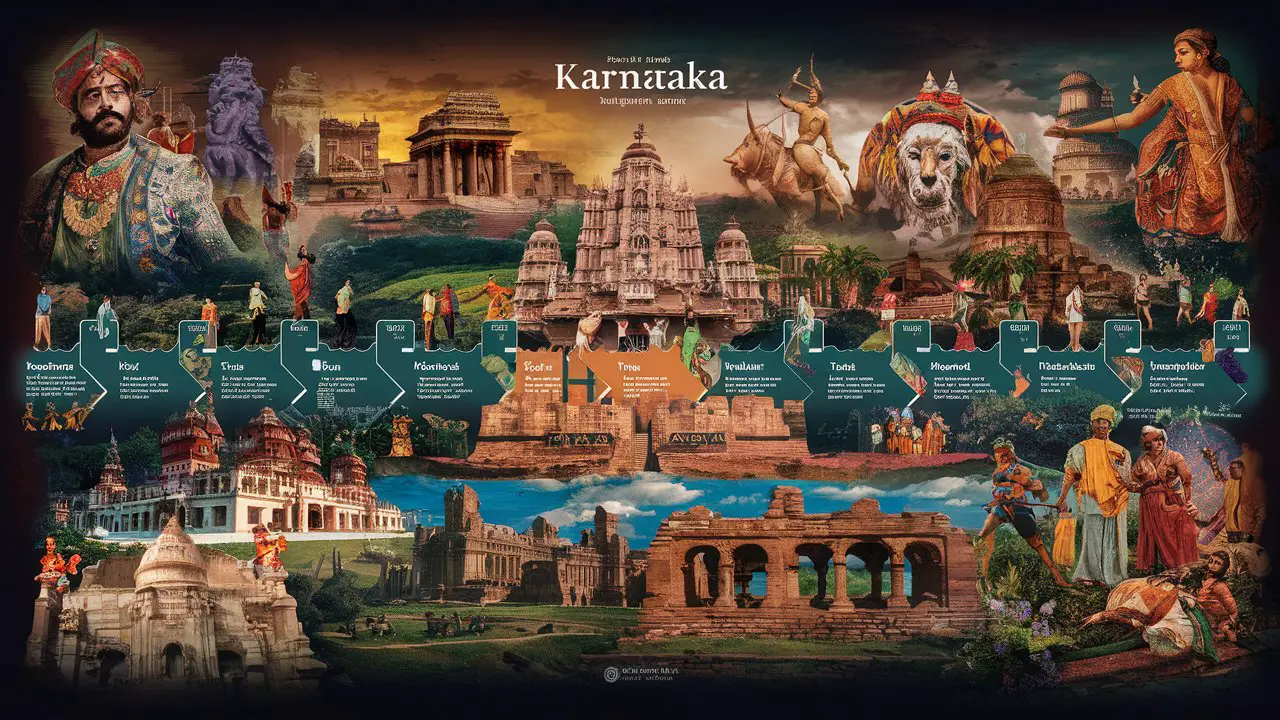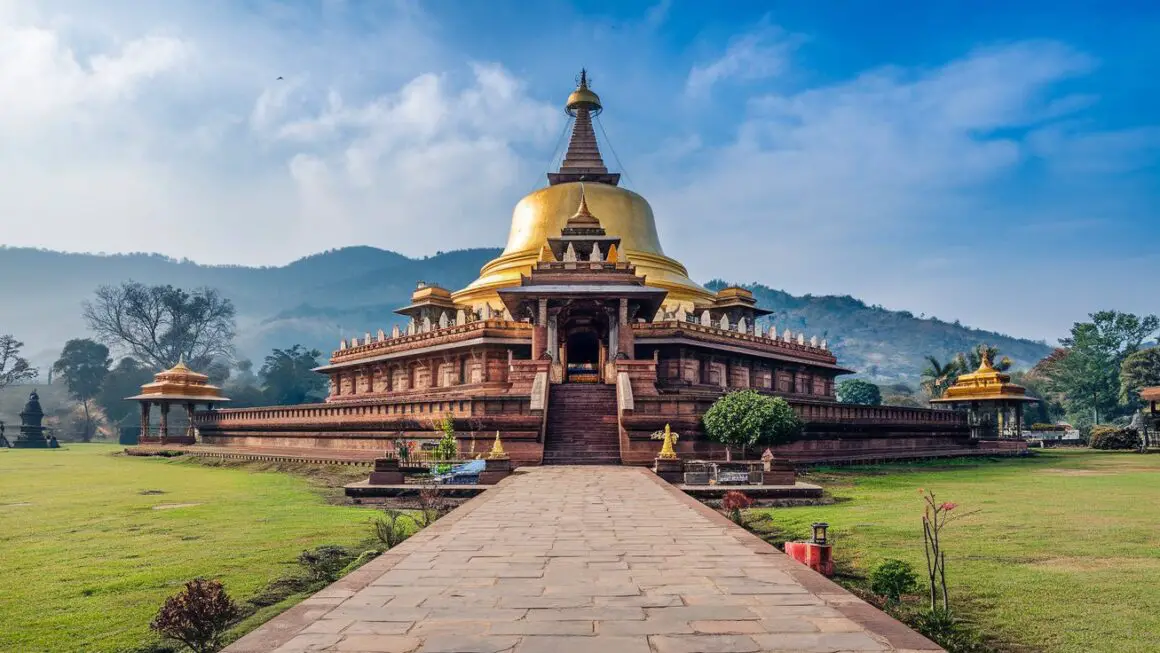Introduction
Karnataka, a state located in the southwestern region of India, boasts a rich and varied history that has significantly contributed to the cultural and political tapestry of India. Known for its diverse culture, ancient architecture, and thriving economy, Karnataka’s past is as fascinating as its present. This article delves into the history of Karnataka, exploring its ancient dynasties, medieval transformations, colonial impacts, and modern advancements. Understanding this history is not only relevant for appreciating Karnataka’s unique identity but also essential for recognizing its role in shaping India’s broader narrative.
Ancient Karnataka
Prehistoric Period and Early Inhabitants
Karnataka’s history dates back to prehistoric times, with evidence of human habitation in the region as early as the Paleolithic era. Archaeological findings, such as hand axes and other stone tools, suggest that early humans settled in the region around 500,000 years ago. The discovery of Neolithic settlements, particularly in the northern parts of Karnataka, indicates that agriculture and animal husbandry were practiced by 3000 BCE. These early inhabitants laid the foundation for the region’s agrarian culture, which continues to thrive today.
Influence of the Mauryan Empire
In the 4th century BCE, Karnataka came under the influence of the Mauryan Empire, founded by Chandragupta Maurya. The Mauryan emperor Ashoka, known for his role in spreading Buddhism, extended his rule over Karnataka. The edicts of Ashoka found in places like Sannati provide evidence of this period, highlighting the spread of Buddhism and the administrative prowess of the Mauryan rulers. The Mauryan influence left a lasting legacy on the region’s cultural and religious landscape.
Dynastic Rule
Kadamba Dynasty
The Kadamba Dynasty, established in the 4th century CE, was the first indigenous dynasty to rule over Karnataka. Founded by Mayurasharma, the Kadambas made significant contributions to the region’s cultural and political development. They introduced the Kannada script, which laid the groundwork for the rich literary tradition that followed. Their capital, Banavasi, became a center of learning and culture, attracting scholars and artists from across the subcontinent.
Chalukya Dynasty
Following the Kadambas, the Chalukya Dynasty rose to prominence in the 6th century CE. The Chalukyas, with their capital at Badami, were known for their architectural innovations and military prowess. They constructed magnificent temples, such as the rock-cut temples of Aihole and Pattadakal, showcasing intricate carvings and pioneering structural techniques. The Chalukyas also played a crucial role in the development of the Kannada language and literature, with several works of poetry and prose emerging during their reign.
Rashtrakuta Dynasty
The Rashtrakuta Dynasty, which ruled from the 8th to the 10th century CE, was one of the most powerful empires in India during its time. Their capital, Manyakheta, became a thriving hub of commerce and culture. The Rashtrakutas were patrons of art and literature, and their reign saw the creation of iconic monuments such as the Kailasa temple at Ellora. They also encouraged the growth of Kannada and Sanskrit literature, with renowned poets like Pampa and Ponna contributing to the region’s literary heritage.
Hoysala Empire
The Hoysala Empire, which flourished between the 10th and 14th centuries CE, is renowned for its architectural achievements. The Hoysalas constructed intricately carved temples, such as the Chennakesava Temple at Belur and the Hoysaleswara Temple at Halebidu, which are considered masterpieces of Indian temple architecture. Their unique style, characterized by detailed sculptures and innovative designs, influenced subsequent architectural developments in South India. The Hoysalas also promoted literature, with significant works produced in Kannada and Sanskrit.
Vijayanagara Empire
The Vijayanagara Empire, founded in the 14th century CE, marked a golden era in Karnataka’s history. The empire, with its capital at Hampi, became a center of art, culture, and trade. The Vijayanagara rulers, such as Krishnadevaraya, were great patrons of literature and the arts, fostering an environment where poets, musicians, and artists thrived. The empire’s architectural legacy is evident in the ruins of Hampi, a UNESCO World Heritage site, which showcases grand temples, palaces, and marketplaces. The Vijayanagara period also saw the consolidation of Hindu culture and the resistance against invading forces from the north.
Medieval Karnataka
Bahmani Sultanate
The decline of the Vijayanagara Empire in the 16th century paved the way for the rise of the Bahmani Sultanate in the northern part of Karnataka. The Bahmanis established their capital at Gulbarga, and later Bidar, and played a significant role in the region’s political landscape. They introduced Persian culture and architecture, leaving behind impressive structures such as the Gol Gumbaz and the Jama Masjid. The Bahmanis also contributed to the development of the Deccani style of art and architecture, blending indigenous and Persian influences.
Bijapur Sultanate
The Bijapur Sultanate emerged as a prominent power in the 16th century, following the fragmentation of the Bahmani Sultanate. Under rulers like Ibrahim Adil Shah II, Bijapur became a center of culture and learning. The sultanate is known for its architectural marvels, including the Gol Gumbaz, which features the second-largest dome in the world. The Bijapur rulers were patrons of the arts, promoting music, painting, and literature. The period also saw the development of the Dakhni language, a precursor to modern Urdu.
Impact of Islamic Rule
Islamic rule in Karnataka brought about significant cultural and architectural transformations. The introduction of Persian art, architecture, and administrative practices influenced the region’s development. The fusion of Hindu and Islamic styles gave rise to the unique Deccani architecture, characterized by intricate carvings and grand structures. This period also saw the growth of Sufism, with several Sufi saints settling in Karnataka, contributing to the region’s spiritual and cultural diversity.
Colonial Period
Advent of European Powers
The 16th century witnessed the arrival of European powers in Karnataka, beginning with the Portuguese, who established trade links along the western coast. The French, Dutch, and British followed, vying for control over the lucrative spice trade. The competition among these colonial powers had a profound impact on Karnataka’s political and economic landscape, leading to alliances and conflicts with local rulers.
British Colonization and Its Impact
By the 18th century, the British East India Company had established its dominance over Karnataka. The defeat of Tipu Sultan, the ruler of Mysore, in 1799 marked the consolidation of British control over the region. The British introduced new administrative and economic policies, transforming Karnataka’s agrarian economy into a more diversified one. The introduction of railways, roads, and modern education systems paved the way for social and economic development. However, British rule also led to the exploitation of resources and the suppression of local industries.
Post-Independence Era
Formation of Karnataka State
Following India’s independence in 1947, the state of Mysore was reorganized to form the state of Karnataka in 1956, uniting Kannada-speaking regions. This reorganization was part of a broader effort to create linguistic states in India, fostering regional identity and cultural cohesion. The formation of Karnataka marked a new chapter in the state’s history, enabling focused development and governance.
Economic and Political Developments
Post-independence Karnataka witnessed significant economic and political changes. The state’s economy diversified, with the growth of industries such as textiles, manufacturing, and information technology. Bengaluru, the capital city, emerged as a major IT hub, attracting investments and talent from around the world. Politically, Karnataka has been a key player in national politics, contributing leaders and policies that have shaped India’s democratic framework.
Geography of Karnataka
Location and Topography
Karnataka is located in the southwestern part of India, bordered by the Arabian Sea to the west and surrounded by the states of Goa, Maharashtra, Telangana, Andhra Pradesh, Tamil Nadu, and Kerala. The state encompasses a diverse topography, with the Western Ghats, a UNESCO World Heritage site, running parallel to the coast, and the Deccan Plateau occupying the eastern region. This varied landscape supports a rich biodiversity and offers stunning natural beauty.
Climate and Natural Resources
Karnataka’s climate ranges from tropical monsoon in the coastal regions to semi-arid in the interior areas. The state is blessed with abundant natural resources, including fertile soil, mineral deposits, and extensive forest cover. The Western Ghats are a hotspot for biodiversity, home to numerous endemic species of flora and fauna. Karnataka’s rivers, such as the Kaveri, Tungabhadra, and Krishna, provide vital water resources for agriculture and hydroelectric power.
Culture and Traditions
Language and Literature
Kannada, the official language of Karnataka, has a rich literary tradition dating back over a thousand years. The state has produced numerous poets, writers, and scholars who have contributed to Kannada literature, earning it recognition as one of the classical languages of India. Prominent literary figures include Pampa, Ranna, and Kuvempu, whose works continue to inspire generations.
Festivals and Celebrations
Karnataka is known for its vibrant festivals and celebrations, reflecting its diverse cultural heritage. Major festivals include Dasara, celebrated with grandeur in Mysore, and the Hampi Utsav, which showcases the cultural splendor of the Vijayanagara Empire. Other significant festivals include Ugadi, Sankranti, and Diwali, each marked by unique customs and traditions.
Art and Architecture
The art and architecture of Karnataka are renowned for their diversity and creativity. The state is home to numerous heritage sites, including the temples of Belur, Halebidu, and Pattadakal, which exhibit intricate carvings and innovative designs. The Chitrakala Parishath in Bengaluru and the Mysore Palace are iconic examples of Karnataka’s artistic legacy. Traditional art forms like Yakshagana, a dance-drama, and Gamaka, a form of storytelling, continue to thrive, preserving the state’s cultural heritage.
Economic Development
Agriculture and Industries
Agriculture has traditionally been the backbone of Karnataka’s economy, with the state being a major producer of crops such as rice, sugarcane, coffee, and spices. The introduction of modern farming techniques and irrigation projects has enhanced agricultural productivity. In addition to agriculture, Karnataka has developed a robust industrial sector, with industries such as textiles, steel, and aerospace contributing to the state’s economic growth.
IT and Biotechnology Sectors
Karnataka, particularly its capital Bengaluru, is known as the “Silicon Valley of India” due to its thriving information technology industry. The state is home to numerous IT companies, ranging from startups to global giants, driving innovation and economic growth. Karnataka is also a leader in the biotechnology sector, with advancements in research and development contributing to healthcare and agricultural solutions.
Educational and Social Progress
Development of Education
Karnataka has made significant strides in education, with a focus on both primary and higher education. The state is home to prestigious institutions such as the Indian Institute of Science (IISc), Indian Institutes of Technology (IIT), and National Institutes of Technology (NIT), attracting students and researchers from across the globe. The emphasis on education has played a crucial role in Karnataka’s socio-economic development, providing a skilled workforce for various industries.
Social Reforms and Movements
Karnataka has been at the forefront of social reforms and movements, addressing issues such as caste discrimination, gender inequality, and poverty. Prominent social reformers like Basava and Narayana Guru advocated for equality and social justice, inspiring movements that continue to impact society. The state’s progressive policies and initiatives have contributed to improved healthcare, education, and social welfare, fostering inclusive growth and development.
Political Landscape
Major Political Parties and Figures
Karnataka’s political landscape is characterized by a vibrant democracy, with several major political parties playing significant roles in governance. The Indian National Congress, Bharatiya Janata Party (BJP), and Janata Dal (Secular) are the key parties that have shaped the state’s political trajectory. Prominent political figures from Karnataka, such as S. Nijalingappa, D. Devaraj Urs, and S. M. Krishna, have made notable contributions to both state and national politics, advocating for development and social welfare.
Role in National Politics
Karnataka has played a crucial role in India’s national politics, contributing leaders and policies that have influenced the country’s governance and development. The state’s strategic location and economic significance make it a key player in shaping national policies and initiatives. Karnataka’s political influence extends beyond its borders, impacting regional and national political dynamics.
Modern Karnataka
Urbanization and Infrastructure
Karnataka has experienced rapid urbanization, with cities like Bengaluru, Mysore, and Mangalore becoming major urban centers. The state’s infrastructure development has kept pace with this growth, with investments in transportation, housing, and public services enhancing the quality of life for its residents. The expansion of metro rail networks, highways, and airports has improved connectivity, facilitating trade and tourism.
Technological Advancements
Karnataka is at the forefront of technological advancements, with innovations in IT, biotechnology, and aerospace driving its economic growth. Bengaluru, in particular, has become a hub for startups and innovation, attracting entrepreneurs and investors from around the world. The state’s emphasis on research and development has positioned it as a leader in technology-driven solutions, contributing to advancements in various sectors, including healthcare, agriculture, and manufacturing.
Challenges and Opportunities
Environmental Concerns
Karnataka faces several environmental challenges, including deforestation, pollution, and water scarcity. The state’s rapid industrialization and urbanization have put pressure on its natural resources, necessitating sustainable development practices. Efforts to conserve biodiversity, promote renewable energy, and implement eco-friendly policies are crucial for addressing these concerns and ensuring a sustainable future.
Socio-Economic Challenges
Despite its economic progress, Karnataka faces socio-economic challenges such as poverty, unemployment, and inequality. Addressing these issues requires targeted policies and initiatives that promote inclusive growth and social welfare. Empowering marginalized communities, enhancing education and healthcare access, and fostering economic opportunities are essential for overcoming these challenges and building a prosperous society.
Future Prospects
Vision for Sustainable Growth
Karnataka’s vision for sustainable growth focuses on balancing economic development with environmental conservation and social welfare. The state’s policies aim to promote innovation, enhance infrastructure, and ensure equitable access to resources and opportunities. By leveraging its strengths in technology, education, and industry, Karnataka is poised to achieve sustainable growth that benefits all its citizens.
Potential for Innovation and Development
Karnataka’s potential for innovation and development is immense, with opportunities in emerging sectors such as renewable energy, biotechnology, and digital technology. The state’s vibrant ecosystem of startups, research institutions, and skilled workforce provides a strong foundation for continued growth and development. By fostering an environment of innovation and entrepreneurship, Karnataka can position itself as a leader in the global economy, driving advancements that address global challenges and improve quality of life.
Conclusion
Karnataka’s historical journey is a testament to its resilience, diversity, and ability to adapt to changing times. From ancient dynasties and medieval empires to colonial influences and modern advancements, the state’s rich history has shaped its unique identity and contributed to its vibrant culture. As Karnataka continues to evolve, it faces both challenges and opportunities that require strategic planning and collaboration. By embracing its heritage and leveraging its strengths, Karnataka can achieve sustainable growth and development, contributing to India’s progress and prosperity.














